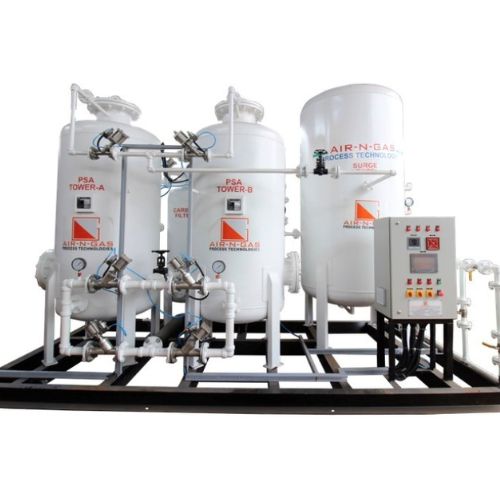24/7 Phone Services
-
-
Visit Our Place
S. G. Highway, Ahmedabad - 380051

PSA Oxygen Gas Generator Work
In an era where reliable, uninterrupted oxygen supply is more critical than everespecially in healthcare and industrial settings a PSA Oxygen Gas Generator offers a game‑changing solution. One leading name in this field, Maas Air N Gas, delivers cutting‑edge on‑site oxygen generation systems with high efficiency and minimal operating costs. This article explores how PSA technology works, why Maas Air’s systems are unique, and where they can be applied.

PSA Oxygen Gas Generator work?
A PSA (Pressure Swing Adsorption) Oxygen Generator separates oxygen from ambient air by selectively adsorbing nitrogen using zeolite molecular sieves (ZMS). Compressed, dried air flows through one of two adsorption towers; the zeolite preferentially captures nitrogen molecules, allowing a stream of oxygen‑rich gas (typically 90–95%) to exit. While one tower is in production mode, the other regenerates by releasing the adsorbed nitrogen under reduced pressure. These alternating cycles deliver a continuous, automated oxygen flow (Maas Air N Gas, Wikipedia).
How Maas Air N Gas PSA Oxygen Systems Stand Out
Innovative ZMS Technology & Twin‑Tower Automation
Maas Air employs a specialized grade of zeolite molecular sieve (ZMS) in its twin‑tower PSA design. After compressed air is dried via a refrigerated dryer, it enters one adsorption vessel; when saturated, the system automatically switches to the other vessel. The towers regenerate independently to ensure seamless operation (Maas Air N Gas).

Fully Automated “Fit‑and‑Forget”
These systems are engineered for completely automated, minimal‑supervision operation. Once installed, the unit runs autonomously—ideal for hospitals or industries needing constant supply without extensive onsite staffing (Maas Air N Gas).
Scalable Capacity & High Purity
- Standard twin-tower PSA units deliver up to 93–95% oxygen purity at approximately 150 Nm³/h.
- VPSA (three‑tower) setups scale from 150 to 1,500 Nm³/h.
- VSA configurations serve demands beyond 1,500 Nm³/h (Maas Air N Gas).
Energy & Cost Efficiency
By generating oxygen from ambient air onsite, facilities eliminate the recurring cost of cylinder deliveries and long-term storage. This direct production significantly reduces operational expenses while offering environmentally friendly, sustainable use (Maas Air N Gas).
PSA Oxygen Gas Generator in india: The Working Cycle
- Air Intake & Compression: Ambient air (21% O₂, 78% N₂) is compressed and filtered to remove moisture and particulates.
- Air Drying: A refrigerated dryer ensures the compressed air is dry before entering the adsorption beds.
- Adsorption Phase: In one adsorption tower, the zeolite filters out nitrogen molecules, allowing oxygen to pass.
- Desorption & Regeneration: When the sieve is saturated, pressure is reduced. Nitrogen is vented, and the bed regenerates.
- Continuous Alternation: Towers alternate—while one adsorbs, the other regenerates—to maintain a steady stream of oxygen.
- Surge Vessel & Backpressure Control: Outgoing oxygen is channeled into a surge vessel via a backpressure regulator for steady delivery (Maas Air N Gas, Wikipedia, Maas Air N Gas).
Applications: From Hospitals to Industries
Medical & Healthcare
PSA plants are essential for hospitals, clinics, and COVID care facilities, ensuring uninterrupted medical‑grade oxygen where cylinder logistics are cumbersome or unreliable (Maas Air N Gas).
Industrial Processes
Industries such as glass manufacturing, chemical production, metal fabrication, and wastewater treatment rely on high‑purity oxygen for processes like combustion, bleaching, oxidation, and biological treatment. On‑site PSA systems offer consistent supply at lower operating costs (Maas Air N Gas).
Environmental & Aquaculture Use
PSA oxygen generators play roles in aquaculture, ozone generation, and wastewater treatment, improving oxygenation efficiency, boosting biological activity, and reducing chemical usage (Onsite Gas, powerbuilder.en.made-in-china.com).
Benefits of Choosing PSA Oxygen Gas Generators
| Benefit | Why It Matters |
|---|---|
| Cost‑Effective | Eliminates cylinder delivery costs and storage logistics |
| Reliable, On‑Demand Supply | Interruptions are virtually eliminated with onsite generation |
| Automated Operation | Minimal human intervention required, simple plug‑and‑play setup |
| Scalable & Customizable | Suitable from small clinics to large industrial setups |
| Energy‑Efficient & Eco‑Friendly | Reduces carbon footprint compared to cryogenic or cylinder oxygen delivery |
| High Oxygen Purity (93–95%) | Fits both medical and industrial grade requirements |
Why Maas Air N Gas?
- Domestic excellence: Based in Gujarat, India, they cater to both industrial and medical sectors.
- ZMS-grade sieve technology: Optimizes nitrogen adsorption for higher yield and purity.
- Plug‑and‑play design: Turnkey installation with minimal site preparation.
- Scalable options: From medium‑capacity PSA to larger VPSA/VSA systems.
- Maintenance friendly: Automated cycling, built-in surge vessel, and backpressure regulation simplify upkeep.
Installation & Maintenance Overview
- Site preparation: Requires stable power, compressed air supply, drainage, and ventilation.
- Installation: Pre-mounted skid systems allow fast on‑site setup.
- Operation: Once powered, the system runs autonomously.
- Maintenance: Periodic replacement of sieves, filters, and checks on dryer and valves. Annual servicing is sufficient for most configurations.
FAQ
1. What purity of oxygen can PSA generators deliver?
Maas Air PSA systems typically provide 93–95% oxygen purity; higher flows (150 Nm³/h to 1,500 Nm³/h) are handled via VPSA or VSA configurations .
2. Are PSA oxygen generators fully automated?
Yes. Maas Air models feature fully automated twin‑tower switching, backpressure regulation, and continuous monitoring requiring minimal human intervention
3. How do PSA systems compare to oxygen cylinders or cryogenic supplies?
PSA plants eliminate delivery logistics and recurring costs. They operate onsite with lower energy and carbon footprints, and offer continuous supply unlike intermittent deliveries .
4. What are the typical industries using PSA oxygen plants?
Common uses include hospitals, glass production, chemical processing, metal fabrication, aquaculture, ozone generation, and wastewater treatment .

Leave A Comment